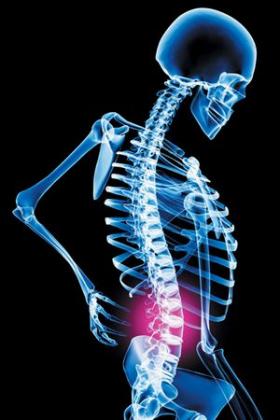
Disc Injuries
Many people (around 200,000) undergo lumbar spine surgery each year. Of those, 20-40% will not become pain free as promised and a full 10% will tragically be worse off following the surgery than they were before.
To understand what is meant by “disc injury” it is necessary to understand the function and make up of the disc itself. To begin with, the disc cannot “slip” as is popularly believed.
Disc Function and Make-up
The role of the disc is to serve as a connector, a spacer and shock absorber for the spine. It can do this because it is made up of a small cartilage pad containing a soft jelly like centre, contained within a surrounding layer of fibrous tissue.
Each one of the bones that make up the spine, called the vertebra, have a disc situated between it. Healthy discs allow normal turning and bending of the spine.
A Disc Cannot “slip”
 Each disc is attached securely to the vertebrae above and below it and cannot move out of its position. What actually happens to cause the pain commonly blamed on a ‘slipped disc’ is that the disc has bulged or herniated, prolapsed and dessicated, usually as a result of trauma or injury.
Each disc is attached securely to the vertebrae above and below it and cannot move out of its position. What actually happens to cause the pain commonly blamed on a ‘slipped disc’ is that the disc has bulged or herniated, prolapsed and dessicated, usually as a result of trauma or injury.
The most painful situation is when the disc is ruptured, putting pressure on the spinal cord and nerve roots causing severe interference with their function.
Joint Fluids
The spinal disc is dependant on the circulation of joint fluids to keep it healthy. When a joint is injured or unable to move freely, it is unable to provide the regular pumping action required to bring nutrients to and expel waste from the disc.
This can have serious consequences for the disc as it has a very poor blood supply of its own and needs this action of the joints to keep it maintained. Disc deterioration can develop to the point where it loses its flexibility, dries out causing the surrounding tissue to crack.
The disc can be compared to a sponge – when it dries out it loses the ability to function the way it is meant to.
Disc Inflammation
Good spinal function can help reduce the occurrence of disc bulging. Regular chiropractic adjustment keeps joints functioning normally which in turn looks after the health of the disc. Chiropractic care can also avoid the risk of inflammation of the surrounding soft tissues, ensuring the health of all parts of the spine.
Chiropractic care enables patients to avoid needless surgery and decreases the use of dangerous pain killing drugs.
About the Disc
The human spine contains 23 discs. Because ageing can cause the fluid content of each disc to diminish it can result in loss of height as each individual grows older. Should each disc lose 3mm loss in each of the 23 discs, this would mean around 6.5cm loss in height altogether.
Did You Know…
If you hold an object next to your body, the weight of that object is equal to the pounds of stress on the disc in your lower back.
But. . .
If you extend your arms fully away from your body and lift the same weight, the pounds of stress on the disc in your lower back can be multiplied by ten!And…
It only takes around 300 pounds of pressure to tear the fibres of a disc. Some people experience as much as 500 pounds of pressure when they sneeze!In Addition…
Most disc injuries are not the result of a single event but are the result of small injuries or microtraumas that occur over time.
Common Herniated Disc Symptoms
• Muscle weakness
• Pain or increase in symptoms when you cough. sneeze or strain while having a bowel movement.
• Pain in the shoulder. arm and hand.
• Pain in the lower right side of the abdomen.
• Incontinence brought on by affected nerves to the bladder and bowel.
• Pain shooting down through your buttock and thigh into the back of your leg.
Types of Injuries to Discs

Annular Tearing
The annulus surrounds the centrally located soft nucleus of the disc structure and is a ligament like any other ligament in the body which can be torn, causing pain. Many episodes of low back pain are probably due to tears in the annulus, allowing the fluid to start leaking out.
Bulging – often called “degeneration” by the GP
The soft jellylike material in the middle of the disc pushes to one side, forward or backward and swelling occurs and this is what is meant by bulging. The nucleus is still contained within the tough outer fibres of the disc but can cause pressure and painful symptoms due to the distortion caused by being “squeezed” out of shape.
Herniation or Prolapse
The tissues located in the centre of the disc can be placed under so much pressure that it can cause the annulus to rupture against one or more of the spinal nerves. The soft jellylike material from the nucleus in the middle of the disc ruptures through the annular fibres and oozes out,
Prolapse or Extrusion
A piece of disc material separates away and becomes a fragment or a free-floating piece. This is often associated with exception pains around the spine and into either the upper or lower limbs – depending on the site of the disc injury.
Sequestration
A piece of disc material separates away and becomes a fragment or a free-floating piece. A sequestion is a serious neurological event. Usually the disc material sequestrates into the spinal cord canal. That is the inner parts of the disc rupture through the annulus and then push back onto the spinal cord itself. This is usually exceptionally painful and may result in for example; extensive weakness and numbness of the genital area and leg pains.
Dessication
The disc losses its fluid content and degenerates down to a rough, worn-down or worn-out appearance. This occurs just before the bones fuse to each other. Basically, the disc is drying out.
Henry Ford, Rabbits & Chiropractic
An ugly two-inch long and quarter-inch wide dark pink scar is slashed across my right shoulder.
This is a remnant of what will most likely be the last office job I will ever have.
It is, however, not the only remnant. I also have the misfortune of being one of over 2.5 million people in Australia who suffer from chronic pain.





